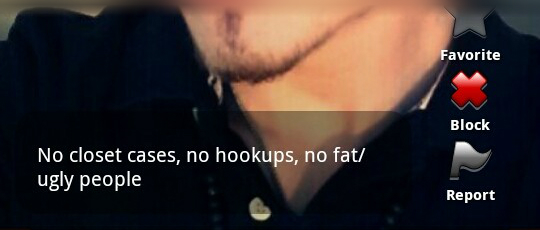In an increasingly digital world, vestiges of the romantic past grow increasingly remote and rare. Old-fashioned dating has been supplanted largely by online dating communities such as eHarmony, OKCupid, and Match.com. Beyond these more mainstream (and somewhat accepted) love-finding services, there exists a more secretive, more sex-focused, and location-oriented arena of lustful personal interactions. Nowhere is this more prevalent than in gay/bi male communities.
When one has access to multiple devices (smartphone, tablet, laptop), the accessibility of hookups grows exponentially. Released for the iPhone in 2009, Grindr is the most popular location-based app for gay and bi guys to find each other and chat, often leading to hook-ups, dates, or even relationships. Grindr has increasingly grown in popularity, serving four million users as of June 2012.
This always-on culture’s migration to the dating world has essentially commodified dating and sex into a by-the-numbers, increasingly body-oriented, racist, and even self-homophobic environment. Stats are front and center of the profile, denoting age, weight, race, and a small space for details, if you wish to provide them.
Taking a look at the average Grindr for a specific area, the user is greeted with a bevy of pictures of faceless chests. The focus is on the abs or occasionally back muscles, with a few interspersed pictures of faces or entire bodies. Many users have no picture, or a black background, cherry-picking people with whom to chat based purely upon a single picture of them.
 When one actually delves into the profiles, he is not often met with information about the person, but often acronyms about hooking up such as NSA (no strings attached) and Neg (HIV negative). In addition to that, the user can be greeted with ageism (such as no one over 30), racism (no Asians, etc.), or even self-hating and homophobic requirements such as “straight-acting,” “mascs only,” or “no femmes.”
When one actually delves into the profiles, he is not often met with information about the person, but often acronyms about hooking up such as NSA (no strings attached) and Neg (HIV negative). In addition to that, the user can be greeted with ageism (such as no one over 30), racism (no Asians, etc.), or even self-hating and homophobic requirements such as “straight-acting,” “mascs only,” or “no femmes.”
Much of the pervasive culture surrounding Grindr, Adam4Adam, and other gay location-based apps promotes bigotry through profiles and Grindr’s passive approach to dealing with these sorts of issues. Hooking up, even in a supposedly more accepting LGBT world, can reflect a darker, economic mode in dating culture.
These issues certainly don’t only exist in the mysterious yet open world of gay dating apps, and they have appeared in new apps for people of all orientations, such as Grindr’s own Blendr, OKCupid’s location-based mobile app, and new websites and apps such as bangwithfriends, Zoosk, and Plenty of Fish. The increasingly expanding world of meeting and chatting with new people for dating or finding a hook-up has crossed over into the straight world.
The parallels are interesting; dick pics (pictures of penises) are prevalent throughout both, as are almost instant offers to have sex. And the bigotry on profiles? Just as bad, if not worse, in some cases. Racism is prevalent, as are strict weight limits, especially for women.
Many supporters of monogamy are worried about the effects of apps like Grindr and Blendr, which can often create brief sexual liaisons, figuratively chipping away at what some see as the rock of civilization. Rather than worry about the effects of these apps, it’s more useful to acknowledge the changing culture and learn from it. In a world in which people increasingly meet and date over the internet, using their phones for constant availability, what is love truly? I can’t answer that one, but it’s certainly worth pondering.


Comments are closed.